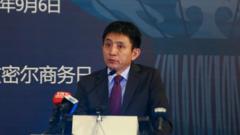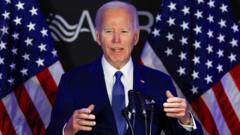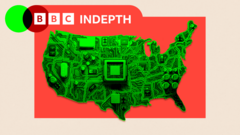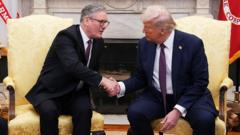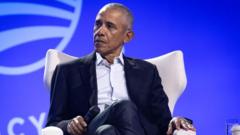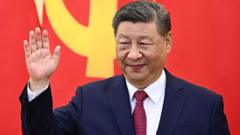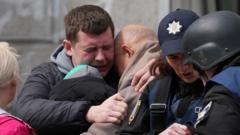Amidst a chaotic backdrop, Treasury Secretary Scott Bessent's influential role in pausing tariffs has led to speculation about shifting power within the White House and its implications for the economy.**
Inside the Turbulent Tariff Tango: Who's Leading Trump's Trade Strategy?**

Inside the Turbulent Tariff Tango: Who's Leading Trump's Trade Strategy?**
A closer look at the dynamics within the Trump administration's tariff team and their impact on global trade.**
In a surprising twist on 9 April, U.S. President Donald Trump’s administration hit the pause button on a series of expansive "reciprocal" tariffs, drawing attention to Treasury Secretary Scott Bessent as the spokesperson for this sudden change. “It took great courage,” stated Bessent at a press briefing among a throng of reporters, showcasing his pivotal role in influencing the decision that sent stock markets soaring. Absent from the briefing were two other key officials, Commerce Secretary Howard Lutnick and trade adviser Pete Navarro, suggesting a shift in the internal dynamics of Trump’s economic team.
As experts speculate, Bessent’s presence in the forefront contrasts sharply with the “bad cop” role played by Lutnick and Navarro, illustrating the evolving power structure within the White House. “He’s playing the good cop,” remarked William Alan Reinsch, a former official overseeing trade policies. Notably, the White House has maintained silence regarding the events that led to the surprise tariff pause, though reports indicate that Bessent’s outreach to the business community significantly swayed Trump’s thinking.
Bessent, who had previously expressed skepticism towards tariffs, utilized his bond market experience to capture the president's attention at a crucial moment. "I think what happened was that Trump wasn't paying attention to the bond market," Reinsch elaborated. By presenting alternative pathways rather than criticizing Trump’s decisions, Bessent appears to have successfully backed the president away from an escalating trade conflict.
The morning of the tariff announcement presented a unique scenario where key officials, including Bessent, Lutnick, and National Economic Council director Kevin Hassett, engaged in discussions about strategy, while others responsible for tariffs were notably absent. This absence indicates a potential reshuffling of roles and influence within the team.
Conflicting statements from the various figures involved provoked confusion and volatility in the markets. Expert commentary suggests the administration was intentionally disseminating differing viewpoints to engage diverse audience segments, complicating the narrative further. "They throw as many spokespeople out there... and flood the zone with opinion," Terry Haines of Pangaea Policy pointed out, drawing parallels to the media's need for clarity amidst confusion.
As the dust settles from recent decisions, analysts anticipate that Bessent may emerge as the primary public face of economic policy, with Lutnick steering negotiations and other players supporting in lesser capacities. This redefined leadership structure could pave the way for improved market stability moving forward. As economist Andrew Hale of the Heritage Foundation posits, “I imagine it will get more certain as we go forward.”
As experts speculate, Bessent’s presence in the forefront contrasts sharply with the “bad cop” role played by Lutnick and Navarro, illustrating the evolving power structure within the White House. “He’s playing the good cop,” remarked William Alan Reinsch, a former official overseeing trade policies. Notably, the White House has maintained silence regarding the events that led to the surprise tariff pause, though reports indicate that Bessent’s outreach to the business community significantly swayed Trump’s thinking.
Bessent, who had previously expressed skepticism towards tariffs, utilized his bond market experience to capture the president's attention at a crucial moment. "I think what happened was that Trump wasn't paying attention to the bond market," Reinsch elaborated. By presenting alternative pathways rather than criticizing Trump’s decisions, Bessent appears to have successfully backed the president away from an escalating trade conflict.
The morning of the tariff announcement presented a unique scenario where key officials, including Bessent, Lutnick, and National Economic Council director Kevin Hassett, engaged in discussions about strategy, while others responsible for tariffs were notably absent. This absence indicates a potential reshuffling of roles and influence within the team.
Conflicting statements from the various figures involved provoked confusion and volatility in the markets. Expert commentary suggests the administration was intentionally disseminating differing viewpoints to engage diverse audience segments, complicating the narrative further. "They throw as many spokespeople out there... and flood the zone with opinion," Terry Haines of Pangaea Policy pointed out, drawing parallels to the media's need for clarity amidst confusion.
As the dust settles from recent decisions, analysts anticipate that Bessent may emerge as the primary public face of economic policy, with Lutnick steering negotiations and other players supporting in lesser capacities. This redefined leadership structure could pave the way for improved market stability moving forward. As economist Andrew Hale of the Heritage Foundation posits, “I imagine it will get more certain as we go forward.”

